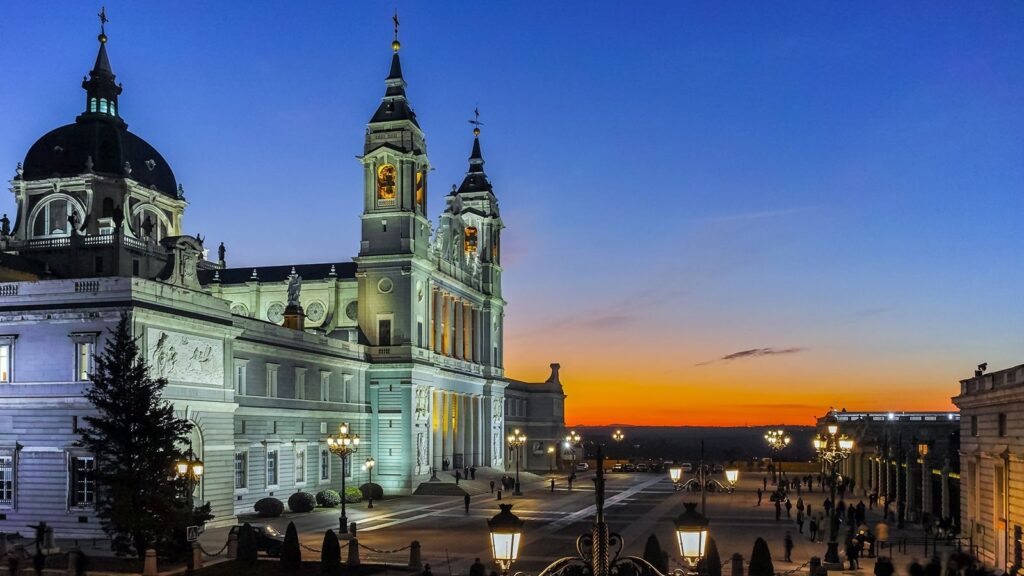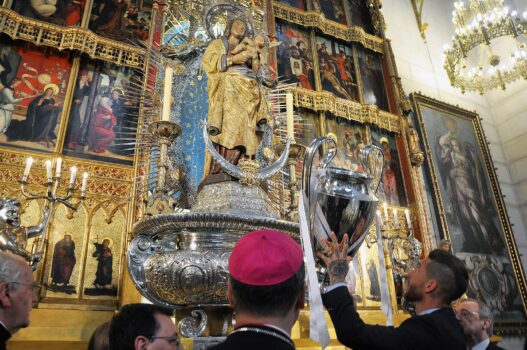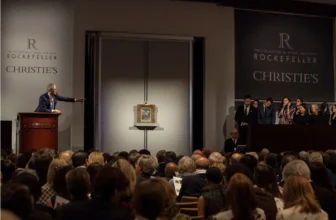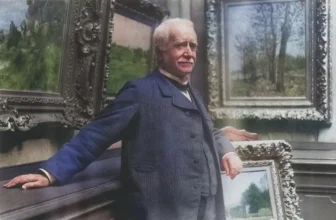Who Is the Virgin Mary of Almudena
The Virgin Mary of Almudena is a Marian title given to a venerated statue of the Blessed Virgin Mary housed in Madrid’s Almudena Cathedral (Santa María la Real de La Almudena). She is the patroness of Madrid, and her feast day is celebrated annually on November 9.
The Virgin Mary of Almudena, known in Spanish as Nuestra Señora de la Almudena, is one of the most revered Marian devotions in Spain, particularly in Madrid. Her story blends legend, history, faith, and a touch of the miraculous. Through the centuries, she has become not only a religious symbol but also a profound cultural icon of the Spanish capital. This is the story of who she is, the miracle associated with her, the legend of her discovery, and her ongoing importance in both religious and national identity.
The name “Almudena” derives from the Arabic word “Al-Mudayna”, meaning “the citadel” or “fortress.” This is a reflection of Madrid’s Moorish past and signifies the blending of cultural and religious influences that shaped the region.
While the origins of the statue are shrouded in legend, the devotion to the Virgin of Almudena dates back to at least the 11th century, closely tied to the Reconquista, the Christian reconquest of Spain from Muslim rule.
The Story of the Virgin of Almudena
According to legend and oral tradition, the story of the Virgin of Almudena begins in the early days of Christianity in Spain, possibly as far back as the 1st century AD. It is believed that Saint James the Apostle, who evangelized the Iberian Peninsula, brought with him a wooden statue of the Virgin Mary.
As Christianity spread throughout Hispania, the statue of the Virgin was placed in a church in what was then a small Roman settlement, future Madrid. When the Moors invaded Spain in the early 8th century, the Christians, fearing desecration or destruction, decided to hide the statue of the Virgin Mary.
To protect it from falling into enemy hands, they concealed the statue within the city walls, behind a stone in a hidden chamber. Over time, the exact location of the statue was forgotten.
Centuries passed, and the city of Madrid came under Moorish control until the 11th century, when King Alfonso VI of Castile and León led efforts to recapture the region. With his conquest of Madrid in 1085, the Christian faith was reinstated, and the search for the long-lost statue of the Virgin began.
The Miracle of the Virgin of Almudena
The miracle that surrounds the Virgin of Almudena is the miraculous discovery of the statue.
As the story goes, King Alfonso VI and his soldiers, along with local clergy and faithful Christians, prayed fervently for guidance to find the statue. Despite extensive efforts, the statue remained hidden. But then, something astonishing occurred.
While processing along the old Moorish walls in public prayer, a section of the wall collapsed suddenly, not due to human force or age, but, as many believed, by divine intervention. Within the rubble, to everyone’s awe, the statue of the Virgin Mary was found, perfectly intact and accompanied by two unburnt candles, still miraculously lit, despite being hidden for over three centuries.
This moment was hailed as a miracle, a sign of divine presence, protection, and the Virgin’s enduring love for her people. The faithful rejoiced, and the statue was immediately enshrined and venerated.
This event marked the rebirth of Christian devotion in Madrid and firmly established the Virgin of Almudena as a patroness and protector of the city.
What Happened to the Virgin of Almudena?
Over the centuries, the Virgin of Almudena remained a central religious figure in Madrid. The original statue, believed to be the one found in 1085, was preserved and displayed with great honor. However, due to wars, fires, and the passage of time, the original statue likely suffered some damage or replacement, though the exact details remain unclear.
Today, the statue that is venerated in Almudena Cathedral is a replica or later interpretation of the original. She is depicted as a dark-skinned Madonna, in the style of the Black Madonnas of Europe, clothed in regal attire and often crowned.
Throughout Spain’s tumultuous history, including the Napoleonic wars, the Spanish Civil War, and modern secular movements, the Virgin of Almudena remained a constant figure of faith, reminding the people of Madrid of their spiritual heritage and divine protection.
The Cathedral of Almudena: A Home for the Virgin

Virgin mary of Almudena Cathedral
The Virgin’s significance became so deeply embedded in the culture of Madrid that it was decided she deserved a monumental home. Construction of the Almudena Cathedral began in 1883, but due to political and financial issues, the building wasn’t completed until over a century later, in 1993.
The cathedral was consecrated by Pope John Paul II, who held a special Mass there, further elevating the status of the Virgin of Almudena.
Today, the cathedral stands opposite the Royal Palace of Madrid and serves as both a place of worship and pilgrimage. Inside, the statue of the Virgin of Almudena rests in a grand altar, dressed in lavish robes that are changed according to the liturgical calendar.
Cultural Celebrations and Feast Day
Every year on November 9, the Feast of the Virgin of Almudena is celebrated with immense joy, devotion, and pageantry.
Highlights of the Festivities Include:
Processions through the streets of Madrid, with the statue of the Virgin carried by the faithful.
Floral offerings, where locals bring flowers to lay at the feet of the Virgin.
Public Masses attended by civic leaders, clergy, and thousands of Madrileños.
Traditional music and dance, blending Spanish folklore with Marian devotion.
It is a time when the city comes alive with a sense of unity, gratitude, and reverence.
Facts About the Virgin Mary of Almudena
Here are some fascinating and important facts about the Virgin of Almudena:
1. Patroness of Madrid
She is officially recognized as the patron saint of Madrid, with her protection invoked by the city’s inhabitants in times of war, plague, or hardship.
2. Name from Arabic Origins
The name “Almudena” is derived from Arabic, signifying the historical confluence of Islamic and Christian cultures in Madrid’s past.
3. One of Spain’s Black Madonnas
The Virgin of Almudena is part of the Black Madonna tradition, a category of Marian icons that are venerated across Europe, particularly in France, Italy, and Spain.
4. Miraculous Preservation
The candles found with the statue when it was rediscovered in 1085 were, according to legend, still burning, despite being hidden for over 300 years.
5. Connection to Reconquista
Her rediscovery coincided with the Christian conquest of Madrid from Moorish rule, symbolizing spiritual rebirth and triumph.
6. Her Cathedral Took Over 100 Years to Build
Madrid’s Almudena Cathedral, her home, took 110 years to complete, one of the longest architectural projects in Spain.
7. Blessed by a Pope
In 1993, Pope John Paul II consecrated the Almudena Cathedral, giving it a special papal blessing, a rare and significant honor.
8. National Symbol
Beyond her religious role, she is a national cultural symbol, appearing in local folklore, literature, and art.
9. Icon of Unity
In Madrid’s diverse and often politically divided history, the Virgin of Almudena has been seen as a unifying figure, transcending political and social boundaries.
Why the Virgin of Almudena Still Matters Today
In an increasingly secular world, the enduring popularity of the Virgin of Almudena speaks to something deeper than tradition, it reflects a longing for connection, identity, and spiritual grounding. Whether seen as a historical icon, a miraculous intercessor, or a comforting maternal figure, the Virgin of Almudena continues to inspire.
She represents the resilience of faith, the preservation of cultural memory, and the enduring power of religious symbols to bring people together in hope, especially during uncertain times.
In Madrid, her image is not just confined to churches. You’ll find her on murals, coins, festivals, and family homes, a quiet but powerful reminder of centuries of devotion.
The story of the Virgin Mary of Almudena is one of faith lost and found, of miracles amidst warfare, and of a motherly presence that has watched over Madrid for over a millennium. From her legendary hiding in the city walls to her miraculous rediscovery, and from her elevation to patroness of Madrid to her central role in the Almudena Cathedral, her journey is deeply interwoven with the history of Spain itself.
For believers, she is a guardian and intercessor. For historians, she is a symbol of Madrid’s transformation. And for all who look upon her with reverence, she is a beacon of peace and perseverance.
As the city of Madrid continues to grow and change, the Virgin of Almudena remains its spiritual heart, reminding generations past and present of the strength found in faith, the beauty of tradition, and the enduring power of divine love. image/americaneedsfatima




